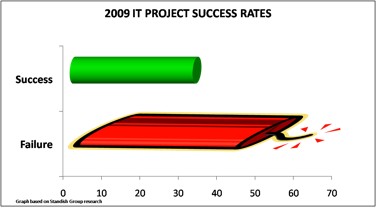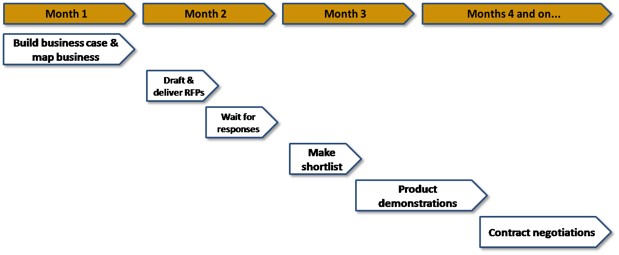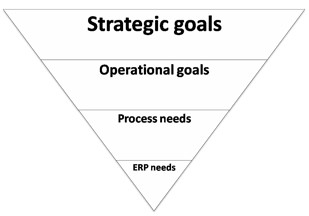
5 steps to selecting the right ERP software
March 3, 2010
By Jonathan Gross
I recently met with the IT director of a North American auto parts distributor. He told me that his company was very unhappy with its new ERP system.
For one, he said, the finance module can’t handle the company’s multiple revenue recognition scenarios. He also told me that the order-processing module couldn’t handle a type of order that accounts for 10 percent of his business’ revenues. In his view, the ERP project is a failure.
 Unfortunately, stories like this are too common. According to the "CHAOS Summary 2009" report, released by IT research firm the Standish Group, 68 percent of all IT projects are considered to be failures.
Unfortunately, stories like this are too common. According to the "CHAOS Summary 2009" report, released by IT research firm the Standish Group, 68 percent of all IT projects are considered to be failures.
The good news is that your company can succeed where others have failed. It can reap the ERP benefits of integration and real-time analytics that have eluded many. The (not so) secret recipe: hard work and commitment. Too many companies cut the wrong corners.
Statistics show that a key driver of ERP success is organizational commitment. This commitment has to start at the system selection phase.
Here is a five-step guide to help you pick the right system.
#1: Allocate Plenty of Lead Time
#2: Build a Strong Business Case
#3: Translate Business Needs into System Requirements
#4: Do the Diligence on the Software
#5: Negotiation
Step #1: Allocate Plenty of Lead Time
Many companies make the mistake of underestimating the amount of time it takes to find the right system.
The selection process can be as short as a few months or as long as a few years if your business operates in an underserved sector (e.g. the heating oil distribution sector). Assuming that your business operates in a well-served market, you should conservatively allocate five months to the selection process.
 Step #2: Build a Strong Business Case
Step #2: Build a Strong Business Case
When a company invests one to three percent of its annual revenues in ERP, it had better have a well-developed business case with well-supported projections.
Developing realistic and achievable projections requires a process-level understanding of current business issues and an understanding of the roadblocks to achieving future goals. When our firm develops business cases for clients, we undertake a fairly comprehensive analysis. First, we map the client’s existing business processes. Then, we analyse those processes in the context of the client’s future business targets. With respect to this latter analysis, our goal is to develop a list of issues that are prioritized in relation to business goals.
Step #3: Translate Business Needs into System Requirements
This is where the business and operational issues are translated into ERP system requirements. Since it’s impossible for any ERP system to address all of a company’s needs, we prioritize and weight each requirement relative to the client’s business goals and constraints.
The weighted requirements should then be assembled into a vendor evaluation scorecard. This scorecard forms the backbone of a request for proposal delivered to ERP vendors.
 Step #4: Do the Diligence on the Software
Step #4: Do the Diligence on the Software
This step contains two sub-stages. First, at the close of tender, the completed RFPs and scorecards are evaluated. Through this preliminary assessment, the initial vendor list is reduced to a shortlist of three to five.
In the second sub-stage, each of the shortlisted vendors is invited to give a detailed product demonstration. At the live demonstration, the vendor shows how its ERP system works in a simulation of your business environment.
Following a post-mortem of the demonstrations, you should be in a good position select the right software package. If doubts remain, you should solicit additional demonstrations. Don’t worry about inconveniencing the vendors. With the size of your potential investment and the high risks of failure, you’re better off double dotting some Is.
Step #5: Negotiation
You might be in the homestretch, but this is no time to sit back. Negotiating contracts for licenses, maintenance and implementation services takes hard work.
Your company should never accept the vendor’s terms without putting up a strong fight. Particularly these days. Negotiating power is shifting over to the buyers’ side. By applying pressure to the right points, you can shave down the sticker price.
Conclusion
By picking the right ERP software, you can position your business to achieve levels of productivity, efficiency and profits that might otherwise be unattainable. If you don’t take the selection process seriously, your business could wind up married to the wrong system. And where would that leave you? As one of those unsatisfied survey respondents lamenting its IT project failures.
Jonathan Gross LL.B., M.B.A., is a lawyer and consultant who specializes in aligning business with IT, selecting IT systems and implementing IT systems. He can be reached at jonathang@pemeco.com and followed at http://twitter.com/Pemeco.